Just before Christmas I met up with my friends Justin and John at the University of California Botanical Garden (UCBG) in Berkeley. The weather forecast called for a break in the rain from mid-morning to mid-afternoon, but on my way to Berkeley—a good hour's drive from Davis—there were pockets when the rain was very heavy and it was so dark that you might have thought it was evening rather than morning. Fortunately, the rain stopped shortly after I'd pulled into the UCBG parking lot, and we were able to walk around without getting wet.
Surprisingly, we had clear views of San Francisco on the other side of the Bay:
Justin, John, and I went straight to the Southern Africa hill to see how far along the aloes were. With the exception of Aloe suprafoliata and a few others, not much is happening yet. In spite of the generous rainfall, colder temperatures in recent weeks have slowed the development of inflorescences. I don't think we'll see much of a flower show until late January at the earliest.
Still, the plants are always cool to look at, and none of us was disappointed.
 |
| Aloe sp. to the left of the steps, Kumara plicatilis on the right |
 |
| Aloe capitata var. quartziticola, sporting its signature purple flush and pushing an inflorescence |
 |
| The shrubby aloe with the small recurved leaves is Aloe kedongensis from Kenya. |
Beyond aloes, the Southern Africa collection includes an amazing assortment of bulbs. South Africa is home to more bulbs than any other area on the planet. The greatest diversity (about 1,200 species) is found in the
Cape Floral Region in the
Western Cape and
Eastern Cape provinces of South Africa.
If you want to go down that particular rabbit hole, I can highly recommend
The Color Encyclopedia of Cape Bulbs by Manning, Goldblatt, and Snijman. This 500-page classic is out of print, but used copies can still be found.
Here are just a few South African bulbs at the UCBG. Many of them are in full leaf now and flower in the summer or fall:
 |
| Boophone haemanthoides, one of the most striking of all Southern African bulbs. In its native habitat, specimens older than 100 years have been reported. |
 |
| Haemanthus coccineus |
 |
| Brunsvigia josephinae |
Back to leaf succulents:
 |
| Colorful Gasteria sp. growing in a crack |
 |
| More Aloe perfoliata ssp. mitriformis |
 |
| Aloe broomii var. tarkaensis |
 |
| The aloe flowering en masse is the book or mustache aloe (Aloe suprafoliata) |
 |
| Spiral aloe (Aloe polyphylla). There used to be several clumps, but I believe they all rotted. |
 |
| Aloe aculeata |
 |
| Aloe aculeata and a coning cycad (Encephalartos lehmannii) |
 |
| Encephalartos lehmannii |
 |
| Straggly Aloidendron barberae against the gray sky. The Berkeley climate isn't reliably hot enough for this tree aloe to thrive. Still, it's doing its best... |
 |
| I have no clue what this is, but there's very little soil here for the roots to grow in |
 |
| Cycads on the Southern Africa hill, with the Japanese Pool across the road |
 |
| Encephalartos natalensis |
 |
| Encephalartos altensteinii and Aloe suprafoliata |
 |
| Aloe suprafoliata |
 |
| Aloe suprafoliata |
 |
| Aloe suprafoliata |
 |
| Aloe mubendiensis |
 |
| Kniphofia northiae, the largest of the pokers. With age, it can form a short trunk up to a foot. |
After we were done with Southern Africa, we swung by the Japanese Pool...
 |
| Japanese Pool |
...and the most magnificent California buckeye (Aesculus californica) anywhere...
 |
| California buckeye (Aesculus californica) |
...to the New World Desert Collection:
 |
Agave mitis var. albidior 'UCBG', with the Southern Africa hill in the background
|
Because the sky was so gray, I didn't take many wide shots, focusing instead on plant “portraits:”
 |
| Agave parryi var. huachucensis (left), Agave filifera (right). The colors were supersaturated because everything was wet. |
 |
| Agave parryi var. huachucensis (left), Agave filifera (right) |
 |
| Agave parryi var. huachucensis (bottom), Agave horrida (top) |
 |
| Most (all?) forms of Agave parryi are enthusiastic offsetters |
The UCBG has a large collection of dryland ferns from California, the Southwest, and other dry areas. In their native habitats, they grow alongside agaves, cacti, and other succulents. They make perfect rock garden plants and, because of their compact size, are easy to tuck into bare spots in just about any xeric landscape. Unfortunately, it's difficult, if not impossible, to find dryland ferns in regular nurseries, even in Arizona (I looked). Online nurseries specializing in ferns (like
Fancy Fronds) often carry some dryland species; the Hardy Fern Foundation has a
spore exchange program for those willing to start from scratch.
 |
| Cheilanthes sp. |
 |
| Bommeria hispida |
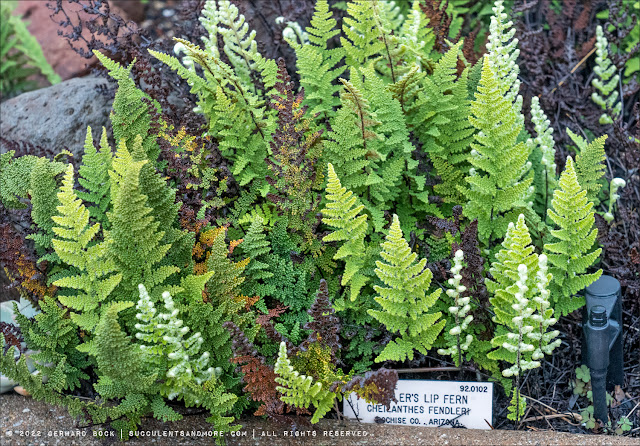 |
| Cheilanthes fendleri |
Other prickly and poky characters:
 |
| Agave shawii ssp. goldmaniana |
 |
| Agave shawii var. shawii |
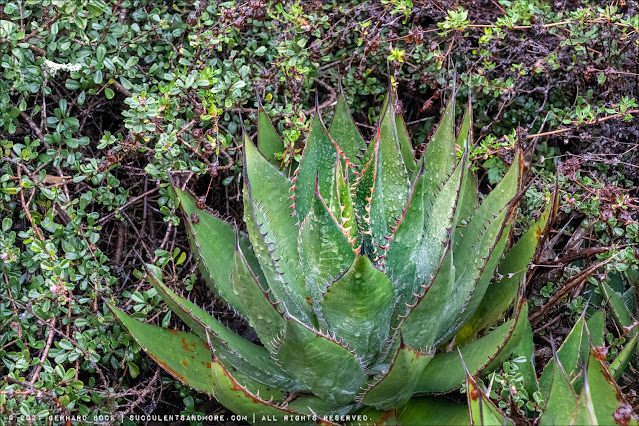 |
| Agave shawii var. shawii |
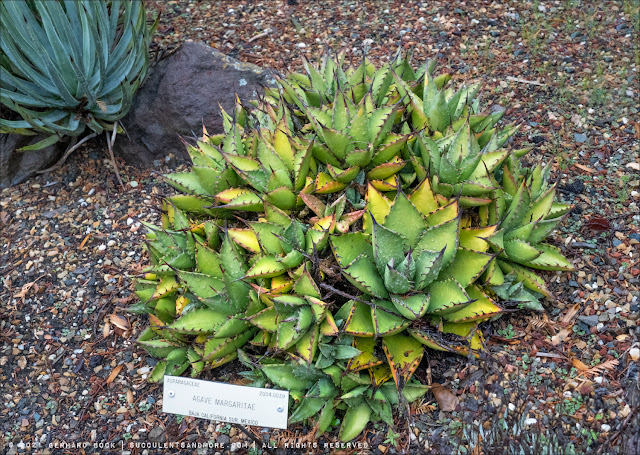 |
| Agave margaritae forming a very tight clump |
 |
| Agave cerulata, the most symmetrical specimen I've ever seen |
 |
| Agave datylio (left), Agave sebastiana (right). The colors were supersaturated because of the rain. |
When I got back to the parking lot, the fog was moving in again, all but obscuring the trees on the ridge above the garden:

The UC Botanical Garden
received 5.18" of rain in the nine days between December 21 and 30, 2021. That's
half of the entire rainfall of the 2020/2021 water year.
All this water will help jumpstart a great spring bloom in the Southern Africa Collection. I'll be back for that!
© Gerhard Bock, 2021. All rights reserved. To receive all new posts by email, please subscribe here.

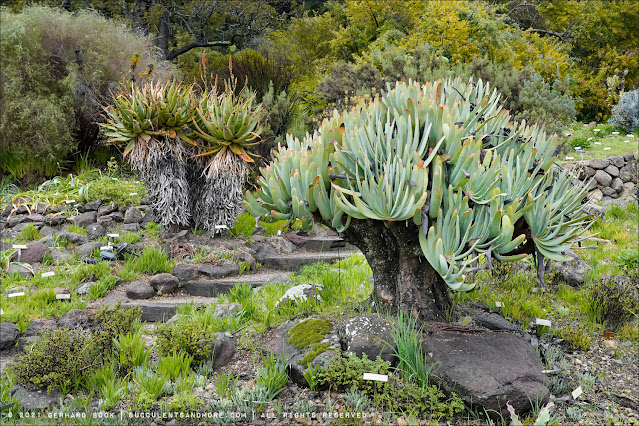
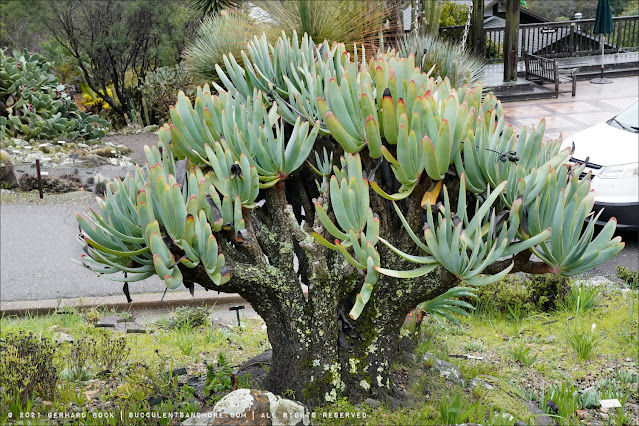

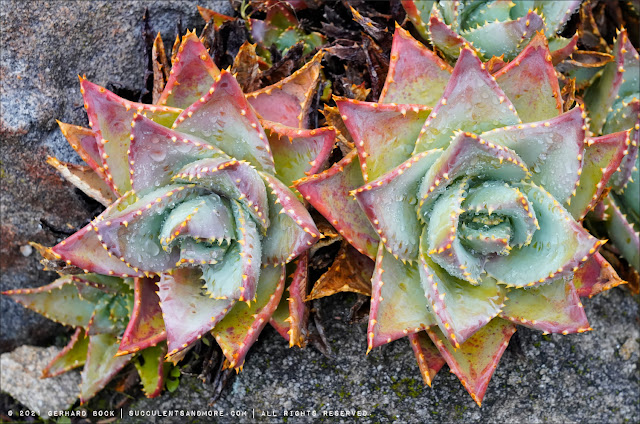


















































I am pathetically overdue for a visit to UCBG. Never went once during the pandemic and I let my membership lapse. I've always wished that they would beef up the inventory on the plant deck. I always try to buy something when I'm there but the selection seems pretty slim considering the wealth of material they have to propagate. I love taking photos there .
ReplyDeleteThe entire plant deck was open this time, with quite a selection of plants. Still, only a small percentage were propagated from the material in the garden.
DeleteSuch a wonderful garden, and another one I've yet to visit. Your post emphasized just how limited my experience with the range of Aoes is too.
ReplyDeleteCome for a Northern California visit! I'll be your guide!
DeleteGreat photos of beautiful plants and than you for the tour. The view of SF is quite stunning.
ReplyDeleteThe view was perfect, esp. considering the weather!
DeleteA wonderful visit. Some photos in particular stood out to me: Kumara plicatilis with it's impressive trunk, anything (!) growing in a rock crevice, California buckeye showing off trunk and limbs, and the vibrant collection of Agave parryi with Agave filifera.
ReplyDeleteWhat finally knock my socks off was the "Lichen growing on a cactus": it's frame worthy!
I'm so glad you liked the lichen photo. I wasn't sure if anyone but me would enjoy it. I always try to include a variety of different photos so there's something for everyone.
DeleteThanks for the photo of the Agave margaritae clump. I do not recall hearing of that one prior to reading Mary Irish's A Place All Our Own: Lives Entwined in a Desert Garden. I promptly did a search when she mentioned it, but couldn't find a great photo.
ReplyDeleteAgave margaritae is not often seen in gardens, public or private.
Delete